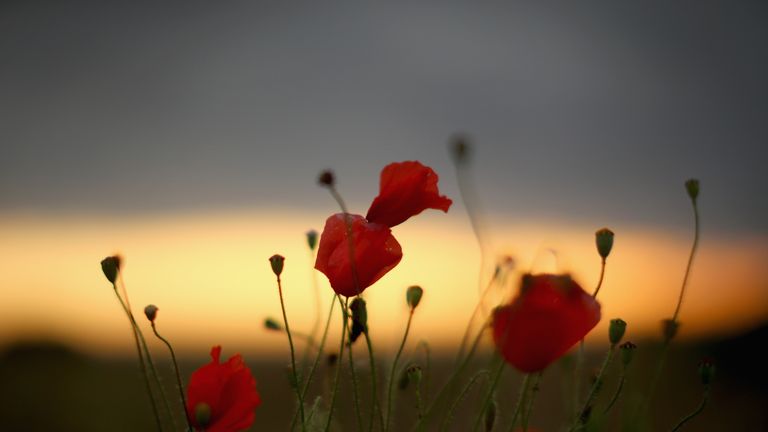Ceremony marks 100 years since Battle of Passchendaele
The offensive, which began on 31 July 1917, claimed the lives of more than half a million British, French and German troops.
Monday 31 July 2017 16:12, UK
Prince Charles has spoken of the "courage and bravery" of the tens of thousands of British soldiers killed during the Battle of Passchendaele, as he led commemorations 100 years after the offensive began.
The Prince of Wales was joined by the Duke and Duchess of Cambridge, Prime Minister Theresa May and the King and Queen of Belgium for a ceremony at the Tyne Cot cemetery near Ypres, where almost 12,000 of those killed in the conflict are buried.
Also attending were 4,000 descendants of those who fought.
Prince Charles said: "We remember it not only for the rain that fell, the mud that weighed down the living and swallowed the dead, but also for the courage and bravery of the men who fought here."
The ceremony included personal stories of some of those present during Passchendaele.
Among them was an account written by Private Bert Ferns, of the Lancashire Fusiliers, who fought in the battle.
"I staggered up the hill and then dropped over the slope into a sort of gully," Private Ferns wrote.
"It was here that I froze and became very frightened because a big shell had just burst and blown a group of lads to bits; there were bits of men all over the place, a terrible sight, men just blown to nothing.
"I just stood there. It was still and misty, and I could taste their blood in the air."
The offensive - which comprised eight battles during the First World War - began on 31 July 1917 and lasted until 10 November 1917, turning fields into liquid mud.
It is estimated to have claimed the lives of 275,000 British Empire troops in the West Flanders region of northern Belgium.
The French lost around 8,500 soldiers, while estimates for German casualties range from 217,000 to 260,000.
On Sunday, the Duke and Duchess of Cambridge joined Mrs May at the Menin Gate monument in Ypres, which is etched with the names of tens of thousands of missing soldiers.
Prince William, flanked by his wife Kate, and Belgium's King and Queen, said their two countries "stand together" to remember those killed.
Speaking as the daily Last Post was played, he said: "The Menin Gate records almost 54,000 names of the men who did not return home; the missing with no known grave.
"Members of our families; our regiments; our nations; all sacrificed everything for the lives we live today."
He added: "During the First World War Britain and Belgium stood shoulder to shoulder.
"One hundred years on, we still stand together, gathering as so many do every night, in remembrance of that sacrifice."
Later, the royal couple and the PM attended a show in Gross Markt square, which included testimonies from soldiers projected on to the walls of the Cloth Hall.
Sky's Defence Correspondent Alistair Bunkall said roads were closed and crowds gathered for the Last Post ceremony.
He said: "This tribute, to British and Commonwealth soldiers, has taken place nightly since 1927 apart from a short break during World War Two when the Germans again occupied Ypres.
"Last night, the under the great arch, watched by thousands who had made the journey to be here, Prince William laid a wreath alongside the King of Belgium.
"Paper poppies fell from the roof, one for each of the 54,391 soldiers whose names are inscribed on the stone panels."
He added: "The scale of loss was immense. The Menin Gate does the sacrifice justice but the numbers of dead are too great to comprehend.
"Passchendaele was perhaps better known then that it is now - history has given the Somme greater prominence. But the human loss was just as great, and the military gains equally minor."
























